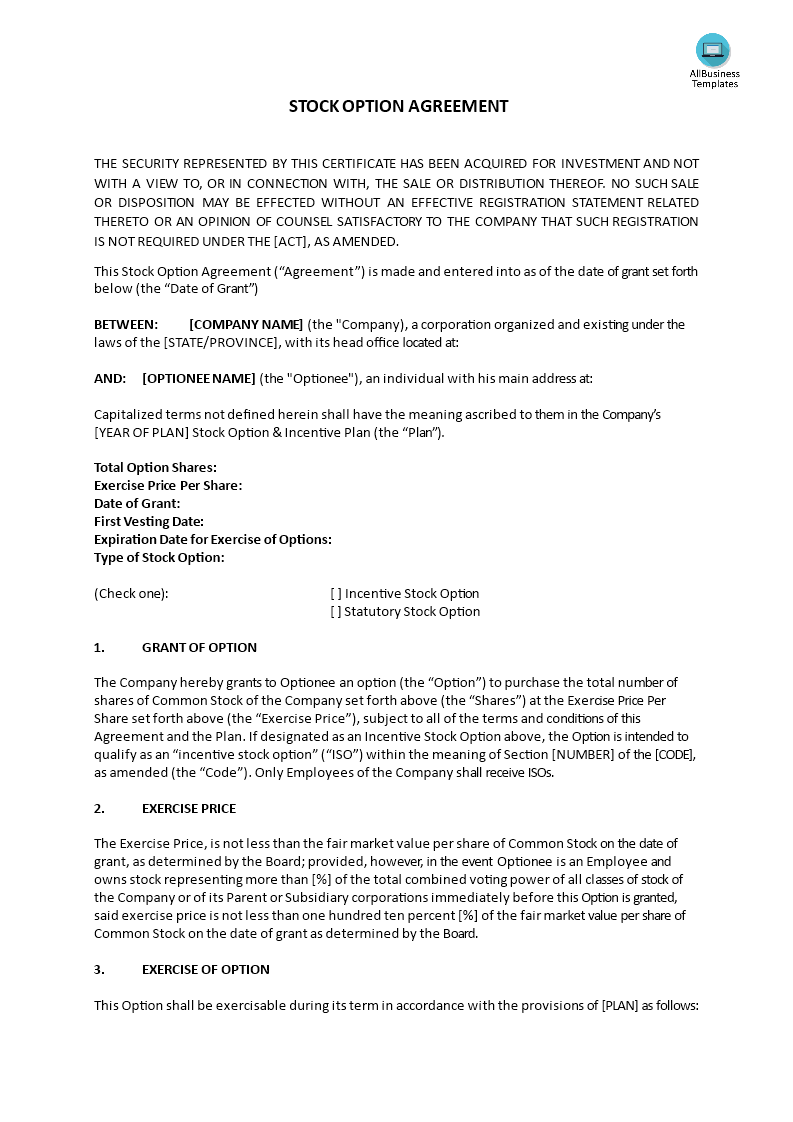Stock Option Agreement
Save, fill-In The Blanks, Print, Done!

Download Stock Option Agreement
Today: USD 2.99
Download It Now

Available premium file formats:
Microsoft Word (.docx)- This Document Has Been Certified by a Professional
- 100% customizable
- This is a digital download (37.43 kB)
- Language: English
- You will receive a link to download the file as soon as your payment goes through.
- We recommend downloading this file onto your computer.
How to write a Stock Option Agreement? In what way do stock options serve their purpose? Our Stock Option Agreement template is a simple and straightforward agreement that provides all the necessary provisions for granting stock options to employees. It includes a dispute resolution clause. Download this Stock Option Agreement now!
A Stock Option Agreement is a legally binding contract between a company and an individual (often an employee or consultant) that grants the individual the right to purchase a specific number of shares of the company's stock at a predetermined price, known as the exercise or strike price, within a specified period of time. This agreement is a common component of employee compensation packages, especially in startup companies and established corporations.
Key components of a Stock Option Agreement typically include:
- Grant Date: The date on which the stock options are awarded to the individual.
- Exercise Price: The price at which the individual can buy the company's stock when they choose to exercise their options. This price is usually set at or above the current market price of the stock at the time of the grant.
- Vesting Schedule: Stock options often have a vesting schedule that specifies when the options become exercisable. Vesting can be based on time (e.g., options vest over a period of four years with a one-year cliff) or performance milestones.
- Expiration Date: The date on which the options expire and can no longer be exercised. This is typically several years after the grant date.
- Number of Options: The total number of stock options granted to the individual.
- Exercise Period: The timeframe during which the individual can exercise their options, typically after they have vested. This can range from a few years to a decade or more.
- Taxation and Exercise Conditions: The agreement may outline the tax implications of exercising the options and any conditions or restrictions on exercising, such as blackout periods.
- Termination Conditions: Details about what happens to the options if the individual leaves the company or if the company undergoes certain events (e.g., acquisition, merger, or IPO).
Stock options are a way to align the interests of employees or other individuals with those of the company, as the value of the options typically increases as the company's stock price rises. They can be a valuable form of compensation and an incentive for individuals to contribute to the company's growth and success. However, it's important for individuals receiving stock options to carefully review the terms of the Stock Option Agreement and consider the potential risks and tax implications associated with exercising and holding stock options. Consulting with a financial advisor or attorney is often recommended when dealing with stock options.
Download this professional legal Stock Option Agreement template if you find yourself in this situation and save yourself time, and effort and probably reduce some of the lawyer fees! Using our legal templates will help you to reach the next level of success in your education, work, and business! However, we still recommend you to consider consulting a local law firm in case of doubt to support you in this matter.
DISCLAIMER
Nothing on this site shall be considered legal advice and no attorney-client relationship is established.
Leave a Reply. If you have any questions or remarks, feel free to post them below.
Related templates
Latest templates
Latest topics
- Excel Templates
Where do I find templates for Excel? How do I create a template in Excel? Check these editable and printable Excel Templates and download them directly! - GDPR Compliance Templates
What do you need to become GDPR compliant? Are you looking for useful GDPR document templates to make you compliant? All these compliance documents will be available to download instantly... - Google Docs Templates
How to create documents in Google Docs? We provide Google Docs compatible template and these are the reasons why it's useful to work with Google Docs... - IT Security Standards Kit
What are IT Security Standards? Check out our collection of this newly updated IT Security Kit Standard templates, including policies, controls, processes, checklists, procedures and other documents. - Letter Format
How to format a letter? Here is a brief overview of common letter formats and templates in USA and UK and get inspirited immediately!
cheese
